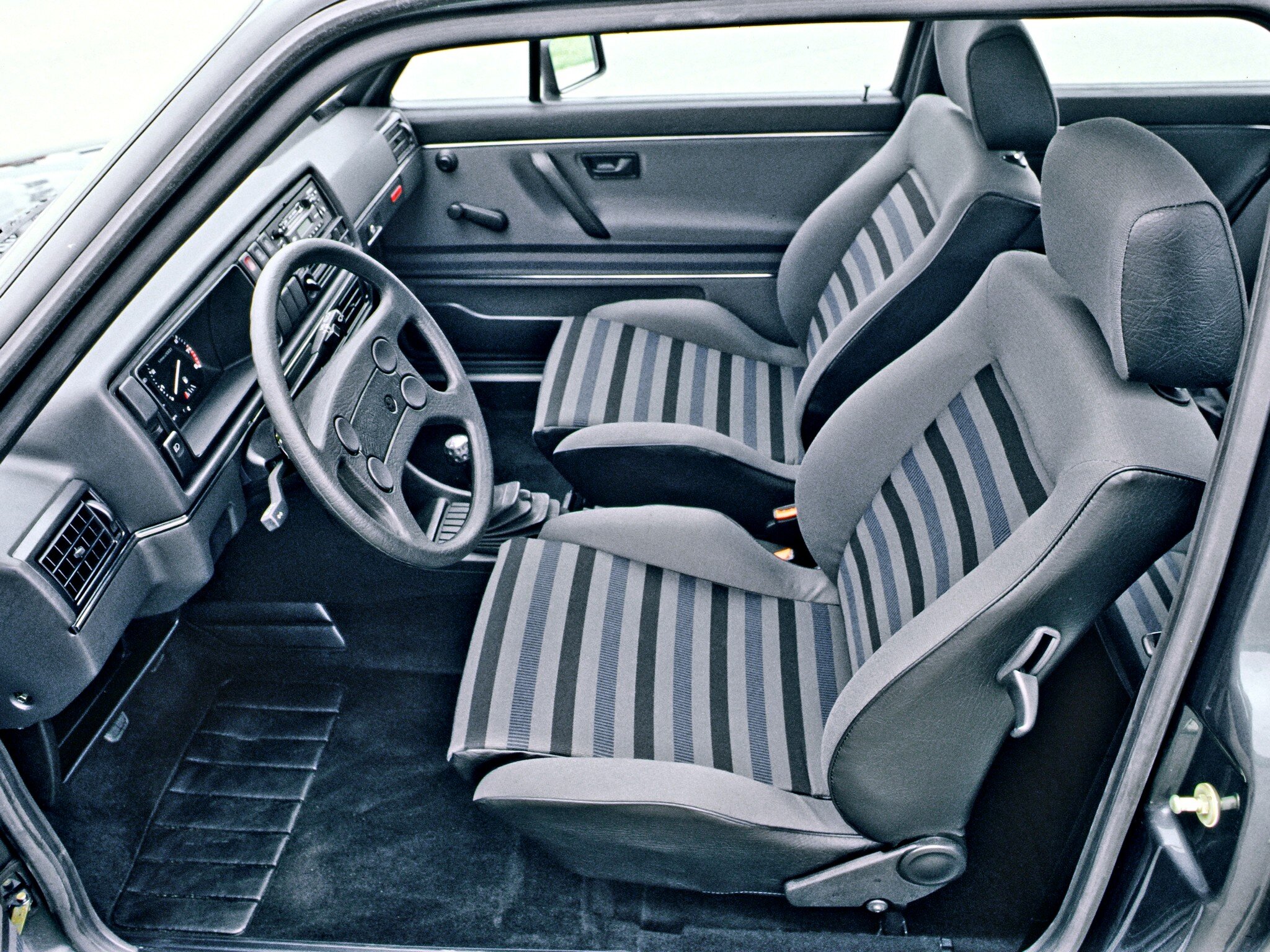Arguably the best all-round hot hatch built during the 1980s, the Volkswagen Golf GTI commands respect and adoration from a serious number of fans. But is that justified, and is buying one now as quality-assured as it was in Thatcher’s decade? Read our comprehensive buying guide to find out…

Volkswagen Golf GTI doing what it does best – cocking an inside-rear wheel
► The full Volkswagen Golf GTI (1984-1992) buyers guide
► Everything you need to check for when buying a Golf GTI
► Search Volkswagen Golf GTIs for sale on Classic Cars for Sale
Although the world-beating Beetle was still a strong seller for Volkswagen in the early 1970s, the German giant knew that wouldn’t be the case forever. A fresh, completely new offering was required, and the Golf was just that. The Mk1 GTI was like nothing that had come before it – it benefitted from light weight and direct steering, combined with innovative suspension treatment (featuring MacPherson struts and offset coil springs) that resulted in masses of driving enjoyment. The Mk2 came along and built on that reputation with a far more solid car.
Mk2 Golf GTIs have been long renowned for their sharp handling and superb agility out on the road. Which engine fitted will certainly have an impact on out-and-out performance, however. The Golf GTI 16V was long seen as the one to go for – and in terms of outright horsepower it’s certainly the market leader – but don’t discount the eight-valver out of hand; it has more low-down torque and as such will likely be easier to drive on a day-to-day basis.
The 16-valve car, on the other hand, only fully unleashes its full 139bhp when you’re screaming along at more than 6000rpm. Of course, which one you go for depends on your personal driving style and what sort of driving characteristics you’re looking for from your Golf. Bear in mind, though, that being a simpler engine, the eight-valve GTI is inherently more reliable and is more than capable of covering at least 200,000 miles between re-builds; by comparison, the 16V will need a refresh after just 150,000 miles – although this is still hardly a shabby performance.

It could be no other car, especially with that golfball gearknob
Volkswagen Golf GTI 8V and 16V buying guide
Bodywork and chassis
When checking any Golf Mk2’s bodywork, the key areas to cast your eyes over include the bottom of the A-pillar below the windscreen. Rust here is bad news, as it’s usually structural and very difficult to repair to a decent standard. Rust can hide under the windscreen rubber too. Cars fitted with a sunroof need checking carefully; rust here is very tricky to fix and best avoided if at all possible.
Otherwise the news is good, as the Mk2’s resistance to rust is far greater than the Golf Mk1’s, so if you’re unfortunate enough to look at one that’s going crusty, chances are it’s been subjected to a poor accident repair in the past.
Brakes
Here’s a hidden area to examine for corrosion. This is the ledge on the bulkhead that supports the brake servo. Debris accumulates here and, especially if combined with leaking brake fluid, can cause the metal underneath to rot through.
Engine
Volkswagen Golf GTI Mk2 models came with a fuel-injected, 1781cc engine, in either 8V or 16V flavours. These engines are known for being generally tough, but most will have done well over 100,000 miles now, so tired units are not unusual, with all the attendant issues. The engine block is rarely a problem, with the exception of the piston rings – any serious wear is most likely to be in the head itself.
The camshaft belt on both the 8-valve and 16-valve models needs replacing every 25,000 miles. Check the belt’s idler pulley at the same time, as worn idlers can seize and cause untold trouble. Here are two fuel pumps, both of which can give trouble. The lift pump inside the fuel tank is prone to failure, causing fuel starvation and subsequent rough running. Brimming the tank can mask the problem, so be suspicious if the fuel gauge shows a full tank on a test drive. The main fuel pump is just ahead of the offside rear wheel. It can be noisy even when working perfectly, so you needn’t worry unduly. Of more concern is a leaking 16V pump – the parts to fix it are expensive and the retaining bolts often seize up, making the replacement job long-winded, and therefore potentially expensive.
If there is a puff of smoke on start up then the valve stem oil seals most likely need replacing, smoke on the overrun is symptomatic of worn valve guides, while a plume of smoke under acceleration indicates worn piston rings. On 8V cars, the oil pump needs replacing every 100,000 miles as a precaution. If it goes, the engine will be trashed. This doesn’t apply to the 16V version, as this has a much tougher pump.
Suspension
The GTI’s front suspension is adjustable for camber, so if the tyres are unevenly worn, then something could be amiss there. Tired dampers are best replaced with gas replacements, while new front strut top mounts are best sourced from Volkswagen itself – although you will pay handsomely for the privilege. If for any reason you need to remove the rear axle, then be extremely careful not to shear the captive studs, as they will take days to repair if damaged.
Transmission
Gearboxes are generally strong, with the synchromesh on second gear being the most common weak point – this shows itself as a ‘crunch’ when changing up quickly from first to second, most prominent when the engine is cold. It’s not necessarily a cause for alarm however, as these units are capable of soldiering on for many miles without any other problems. Renewing the gearbox oil with fresh, high quality replacement fluid will help though.
Sometimes first and fifth gears can become difficult to engage, though this is due to the alignment having shifted rather than the gearbox itself; a simple adjustment will often make a difference. More than 4mm play in the gear lever can be revived with new bushes, or even a short-shift kit, which reduces the throw and comes with new bushes as a matter of course.
Should you buy a Volkswagen Golf GTI Mk2? The CCfS verdict
The Golf GTI Mk2 is a more than attractive proposition. It will be more than capable of taking on daily driver duties and general domestic errands, but will still provide lashings of fun when the working day is done. Bag a good one, and you won’t regret it. The trick is getting hold of one that hasn’t been modified to within an inch of its life. If you can achieve this, then we’d urge you to go for it. The Volkswagen scene is one of the most all-embracing out there too, so whatever model you choose, be assured that there are like-minded people out there on the same wavelength as you.
Introduced in 1984, the GTI Mk2 had one hell of an act to follow, but turned out to be every bit as good to drive as its predecessor, better packaged, just as quick and with far more reassuring brakes. If you want practicality, performance and strength in one affordable package, few cars can deliver like the Mk2 GTI. It is also far less prone to rust than its predecessor, while the choice of both 8V and 16V engines means there is a model to cater for just about every taste.
You might also like

Changes to 16V spec were very subtle indeed – new exhaust tips and a discrete 16V badge
Volkswagen Golf GTI 8V specs and details
Production 1984-1992
Engine capacity 1781cc
Cylinders 4-inline
Valvetrain OHC, 8-valve
Maximum power 112bhp@5800rpm
Maximum torque 109lb ft@3500rpm
Maximum speed 119mph
0-60mph 8.3sec
Fuel economy 32mpg
Gearbox five-speed manual, front wheel drive
Volkswagen Golf GTI clubs and specialists
-
JMR Ltd (John Mitchell Racing)
Units 14/15,
Arunside Business Park,
Littlehampton,
West Sussex BN17 7QUWorkshop: 01903 718684
info@johnmitchellracing.co.uk